CHICAGO: Spending 50 minutes with a cellphone plastered to your ear is enough to change brain cell activity in the part of the brain closest to the antenna.
But whether that causes any harm is not clear, scientists at the National Institutes of Health said, adding that the study will likely not settle recurring concerns of a link between cellphones and brain cancer.
 “What we showed is glucose metabolism (a sign of brain activity) increases in the brain in people who were exposed to a cellphone in the area closet to the antenna,” said Dr Nora Volkow of the NIH, whose study was published in the Journal of the American Medical Association.
“What we showed is glucose metabolism (a sign of brain activity) increases in the brain in people who were exposed to a cellphone in the area closet to the antenna,” said Dr Nora Volkow of the NIH, whose study was published in the Journal of the American Medical Association.
The study was meant to examine how the brain reacts to electromagnetic fields caused by wireless phone signals. Volkow said she was surprised that the weak electromagnetic radiation from cellphones could affect brain activity, but she said the findings do not shed any light on whether cellphones cause cancer.
“This study does not in any way indicate that. What the study does is to show the human brain is sensitive to electromagnetic radiation from cellphone exposures.”
Use of the devices has increased dramatically since they were introduced in the early-to-mid 1980s, with about 5 billion mobile phones now in use worldwide.
Some studies have linked cellphone exposure to an increased risk of brain cancers, but a large study by the World Health Organization was inconclusive.
Volkow’s team studied 47 people who had brain scans while a cellphone was turned on for 50 minutes and another while the phone was turned off.
While there was no overall change in brain metabolism, they found a 7 per cent increase in brain metabolism in the region closest to the cellphone antenna when the phone was on.
Experts said the results were intriguing, but urged that they be interpreted with caution. “Although the biological significance, if any, of increased glucose metabolism from acute cellphone exposure is unknown, the results warrant further investigation,” Henry Lai of the University of Washington, Seattle, and Dr Lennart Hardell of University Hospital in Orebro, Sweden, wrote in a commentary in JAMA.
“Much has to be done to further investigate and understand these effects,” they wrote.
Professor Patrick Haggard of University College London said the results were interesting since the study suggests a direct effect of cellphone signals on brain function.
But he said much larger fluctuations in brain metabolic rate can occur naturally, such as when a person is thinking.
“If further studies confirm that mobile phone signals do have direct effects on brain metabolism, then it will be important to investigate whether such effects have implications for health,” he said.
John Walls, a spokesman for CTIA-The Wireless Association, an industry group, said the scientific evidence so far “has overwhelmingly indicated that wireless devices, within the limits established by the FCC ( Federal Communications Commission), do not pose a public health risk or cause any adverse health effects.”
Volkow said her findings suggest the need for more study to see if cellphones have a negative effect on brain cells. Meanwhile, Volkow isn’t taking any chances. She now uses an ear phone instead of placing a cellphone next to her ear.
“I don’t say there is any risk, but in case there is, why not?”


